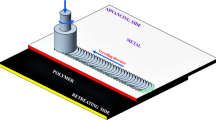Abstract
Friction welding is one of the established solid-state welding techniques with wide aerospace, automobile and industrial applications. For thermoplastic components, it is extremely difficult to join the dissimilar material [e.g., acrylonitrile butadiene styrene (ABS) to polyamide (PA) 6] with friction welding process. For such joining/welding applications, there is a need of strong material compatibility/processing technique. This study highlights melt flow index (MFI) as one of the rheological/flow properties which can be used as controlling parameter for dissimilar thermoplastic friction welding. The twin screw extrusion and fused deposition modeling as melt processing techniques have been used for processing/fabrication of functional/non-functional surfaces/prototypes. The results of study suggest that ABS with 15% Al metal powder by weight (ABS-15Al) and PA6 with 50% Al metal powder by weight (PA6-50Al) have a similar range of MFI as 11.57 and 11.97 g/10 min, respectively (which confirmed the compatibility for joining of both polymers by friction welding). The results are supported by photo-micrographs and mechanical testing.








Similar content being viewed by others
References
Kumar R, Singh R, Hui D et al (2018) Graphene as biomedical sensing element: state of art review and potential engineering applications. Compos Part B Eng. https://doi.org/10.1016/j.compositesb.2017.09.049
Singh R, Kumar R, Mascolo I, Modano M (2018) On the applicability of composite PA6-TiO2 filaments for the rapid prototyping of innovative materials and structures. Compos Part B Eng 143:132–140. https://doi.org/10.1016/J.COMPOSITESB.2018.01.032
Kumar R, Singh R, Ahuja IPS et al (2018) Friction welding for the manufacturing of PA6 and ABS structures reinforced with Fe particles. Compos Part B Eng 132:244–257. https://doi.org/10.1016/j.compositesb.2017.08.018
Singh R, Kumar R, Ranjan N et al (2018) On the recyclability of polyamide for sustainable composite structures in civil engineering. Compos Struct. https://doi.org/10.1016/j.compstruct.2017.10.036
Singh R, Kumar R, Feo L, Fraternali F (2016) Friction welding of dissimilar plastic/polymer materials with metal powder reinforcement for engineering applications. Compos Part B Eng. https://doi.org/10.1016/j.compositesb.2016.06.082
Wagner JR Jr, Mount Iii EM, Giles HF Jr (2012) Extrusion: the definitive processing guide and handbook, 2nd edn
Process E twin-screw extrusion and applications. https://doi.org/10.3139/9781569906064.006
Singh R, Kumar R, Ranjan N (2018) Sustainability of recycled ABS and PA6 by banana fiber reinforcement: thermal, mechanical and morphological properties. J Inst Eng Ser C. https://doi.org/10.1007/s40032-017-0435-1
Ray S, Easteal AJ (2007) Advances in polymer-filler composites: macro to nano. Mater Manuf Process 22:741–749. https://doi.org/10.1080/10426910701385366
Olakanmi EO, Thompson OM, Vunain E et al (2016) Effects of Daniella oliveri wood flour characteristics on the processing and functional properties of wood polymer composites. Mater Manuf Process 31:1073–1084. https://doi.org/10.1080/10426914.2015.1037895
Chaitanya S, Singh I (2017) Processing of PLA/sisal fiber biocomposites using direct- and extrusion-injection molding. Mater Manuf Process 32:468–474. https://doi.org/10.1080/10426914.2016.1198034
Kumar R, Singh R, Ahuja IPS et al (2018) Weldability of thermoplastic materials for friction stir welding: a state of art review and future applications. Compos Part B Eng. https://doi.org/10.1016/j.compositesb.2017.10.039
Squeo EA, Bruno G, Guglielmotti A, Quadrini F (2009) Friction stir welding of polyethylene sheets. 241–146
Gonalves J, Dos Santos JF, Canto LB, Amancio-Filho ST (2015) Friction spot welding of carbon fiber-reinforced polyamide 66 laminate. Mater Lett 159:506–509
Paoletti A, Lambiase F, Di Ilio A (2015) Optimization of friction stir welding of thermoplastics. Procedia CIRP 33:563–568
Simões F, Rodrigues DM (2014) Material flow and thermo-mechanical conditions during friction stir welding of polymers: literature review, experimental results and empirical analysis. Mater Des 59:344–351
Oliveira PHF, Amancio-filho ST, Santos JF, Hage E Jr (2010) Preliminary study on the feasibility of friction spot welding in PMMA. Mater Lett 64:2098–2101
Buffa G, Baffari D, Campanella D, Fratini L (2016) An innovative friction stir welding based technique to produce dissimilar light alloys to thermoplastic matrix composite joints. Procedia Manuf 5:319–331. https://doi.org/10.1016/j.promfg.2016.08.028
Kumar R, Singh R, Ahuja IPS (2018) Investigations of mechanical, thermal and morphological properties of FDM fabricated parts for friction welding applications. Meas J Int Meas Confed. https://doi.org/10.1016/j.measurement.2018.02.006
Singh R, Kumar R, Kumar S (2017) Polymer waste as fused deposition modeling feed stock filament for industrial applications. Ref Modul Mater Sci Mater Eng. https://doi.org/10.1016/B978-0-12-803581-8.04153-9
Singh R, Kumar R, Hashmi MSJ (2017) Friction welding of dissimilar plastic-based material by metal powder reinforcement. Elsevier, New York
Singh R, Kumar R (2017) Development of low-cost graphene-polymer blended in-house filament for fused deposition modeling. Elsevier, New York
Kumar R, Singh R (2018) Prospect of graphene for use as sensors in miniaturized and biomedical sensing devices. Ref Modul Mater Sci Mater Eng. https://doi.org/10.1016/B978-0-12-803581-8.10334-0
Singh R, Kumar R, Ahuja IS (2017) Thermal analysis for joining of dissimilar polymeric materials through friction stir welding BT. In: Reference module in materials science and materials engineering. Elsevier
Abibe AB, Sônego M, dos Santos JF et al (2016) On the feasibility of a friction-based staking joining method for polymer-metal hybrid structures. Mater Des 92:632–642
Funding
Funding was provided by BRNS and UGC.
Author information
Authors and Affiliations
Corresponding author
Additional information
Technical Editor: Márcio Bacci da Silva.
Rights and permissions
About this article
Cite this article
Kumar, R., Singh, R. & Ahuja, I.P.S. Melt processing for enhancing compatibility of aluminum-reinforced acrylonitrile–butadiene–styrene and polyamide 6 for friction welding applications. J Braz. Soc. Mech. Sci. Eng. 40, 378 (2018). https://doi.org/10.1007/s40430-018-1298-y
Received:
Accepted:
Published:
DOI: https://doi.org/10.1007/s40430-018-1298-y




